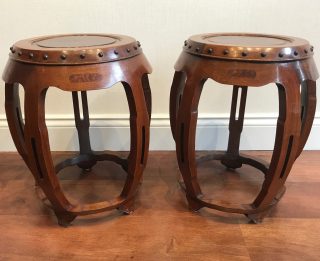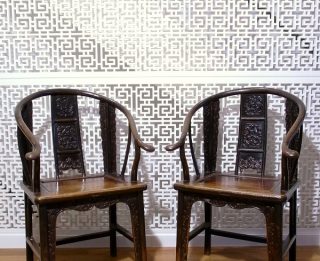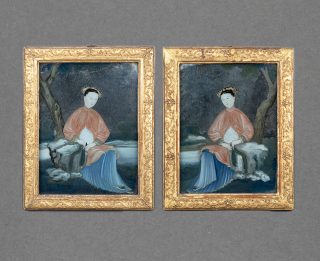What are Chinese Antiques?
For thousands of years, Chinese antiques have beguiled collectors for their intricacy and subtlety, their beautifully detailed artisan craftsmanship and their deep-rooted connection and deference to Chinese history, philosophy and culture.
Asian antiques are as varied and as expansive as China’s history is long and the phrase ‘Chinese antiques’ embodies much, from porcelain, textiles, jewellery, Chinese antique furniture, painting, sculpture and even clothing.
Before the time of wholesale export of Chinese antiques, many beautiful oriental antiques were bought by missionaries, travellers and explorers and transported back from whence they came including western Europe and the Americas. Over the years the pieces were passed down from generation to generation and with the works of art came extraordinarily fascinating back stories.
As awareness of these wonderful Asian antiques grew, the market became competitive and leading Chinese antique dealers such as Marchant Asian Art could offer for sale some of the most stunning Chinese antiques to discerning collectors from all over the world.
Chinese Antiques Through The Ages
Qin Dynasty (221BC – 206BC)
The first Imperial Chinese dynasty included the construction of the Great Wall of China but its rulers were more focused on defence and warfare than art. That said, perhaps the most famous of all Chinese antiques, the 8,000-strong Terracotta Army, a form of funerary art depicting the armies of Emperor Qin Shi Huang, was created during this time.
Han Dynasty (202BC – 220AD)
The Han made incredible contributions to Chinese art and it was during this period that craftsmen started to use porcelain to create what are now some of the world’s most collectible Chinese antiques. It was also during the Han dynasty that jade burial suits were made, of which you can read about later in this article.
Tang Dynasty (618 – 907)
The Tang dynasty heralded a golden age in Chinese art and Chinese antiques. Mural paintings were a major art form where the Chinese, like the ancient Egyptians, liked to adorn their lavish tombs with artwork to be enjoyed in the afterlife. This was also the dynasty when fine ceramics were made including the famous Sancai, or ‘three-colour’ style of brown (or amber), green and a creamy off-white. These stunning Chinese antiques were traded along the Silk Road and today, Chinese antique dealers consider these pieces to be some of the most desirable.
Song Dynasty (960 – 1279)
The Song dynasty saw the development of the scholar-elites, a new social class of men who created a sense of aesthetics defining Chinese society and life in general. Learned men they were, but they were also skilled in the arts and many excelled in wood carving. Many of the Chinese antiques made during the Song dynasty focused on melancholy, loss, and the power and beauty of the natural world reflecting the age in which they lived.
Ming Dynasty (1368 – 1644)
Coinciding with the European renaissance, the Ming dynasty was a period of enlightenment where vast amounts of Asian antiques were manufactured including calligraphy on magnificent scrolls, exquisite textiles and paintings portraying elaborate landscapes, often frightening in their immensity. It was also the time where some of the most famous Chinese antiques were created – the world-famous blue and white Ming pottery – and were exported around the world in huge numbers. Chinese antique dealers are still doing it to this day.
Qing Dynasty (1644 – 1911)
Ruled firmly by the Manchu through a huge military force, while they were strong rulers they kept taxes low, people felt safe and the creativity of what has become today’s Chinese antiques thrived. The Qing were very active in their trade with Europe and the Americas and their stunning oriental antiques, especially the porcelain, were exquisitely decorated with bright colours to appeal to these new markets.
Types of Chinese Antiques
Vessels
Perhaps the most widely collected of all Asian antiques are vessels, including vases, teapots, plates and jugs. Made from clay, glass, jade, bronze and most famously porcelain, some of the most famous and highly sought-after Chinese antique porcelain vessels were made at the famous ‘porcelain town’ of Jingdezhen in north-eastern Jianxi province during the Ming dynasty.
Paintings
Chinese painting is one of the world’s oldest artistic traditions and there are two main techniques in creating these stunning oriental antiques – gongbi (translated as ‘meticulous’) usually depicts a story or narrative and used highly detailed brushstrokes and was usually practised by artisans in the imperial court.
Shuǐ-mò, or ‘water and ink’ is what may be referred to as watercolour painting and was practised by gentlemen and scholars who became very famous. They produced some of the most highly sought-after works that have become highly prized by the leading Chinese antique dealers.
Sculptures
Chinese antique sculptures usually depict people, animals, religious iconography, mythical creatures and narratives. They are made from a number of different materials including wood, glass, clay, bronze and stone but perhaps the most popular material for Asian antique sculptures is jade.
Jade was considered to be the ‘imperial gem’ and it was used to make all manner of objects, from small decorative pieces to full burial suits for the more well-to-do members of the Han dynasty. The ancient Chinese believed that jade prevented flesh from decaying and the dead were encased in suits made from thinly-cut slabs of jade wired together with gold and silver thread. The very best suits took 10 years or more to make and are amongst the most revered Asian antiques.
The most prized form of jade for Chinese antiques is white jade, known in China as ‘mutton fat’ jade which ranges from translucent white to a very light yellow colour.
Chinese Antique Furniture
Chinese antique furniture has its origins in antiquity, and research suggests that the ancient Chinese had a very minimalist mat-level furniture culture, in that they sat cross-legged or knelt on woven mats and used low tables, perhaps with armrests and separated by screens.
Today, what we refer to as classic Chinese antique furniture – cabinets, beds, tables, chairs, stools and wardrobes – was made from the latter part of the fourteenth century at the start of the Ming dynasty right the way up to the start of the twentieth century, or the end of the Qing dynasty.
As with all types of oriental antiques, Chinese antique dealers will tell you that the factors that determine value are the materials, condition, age and provenance. The Chinese antique furniture market is largely driven by the quality of the materials used and two very similar pieces from the same era but made of different types of wood can sometimes mean a difference of hundreds of thousands of pounds.
Most Chinese antique furniture is made from mahogany (‘hongmu’) but the most highly-prized woods are two types of hardwood found on Hainan, China’s largest island. Zitan, a member of the rosewood family, is a dense wood which is very dark in colour (from burnt orange to blackish reds and purples) and the finest Huanghuali wood (‘yellow flowering pear’), also a rosewood, has an almost translucent shimmering surface with abstract patterns that resemble ghostly faces in the grain.
Asian antiques can be very specific in their description, none more so that Chinese antique furniture. Aside from bedframes, most of the pieces are known as ‘hall furniture’ because in imperial China, the hall (or chamber) was the largest room in the house and one where guests were received – much like today’s living or drawing rooms. Naturally, there was a marked difference between the living spaces of an emperor than that of a humble artist but wherever on the hierarchical ladder one resided, it was the place to show off one’s finest Chinese antiques and especially Chinese antique furniture.

























